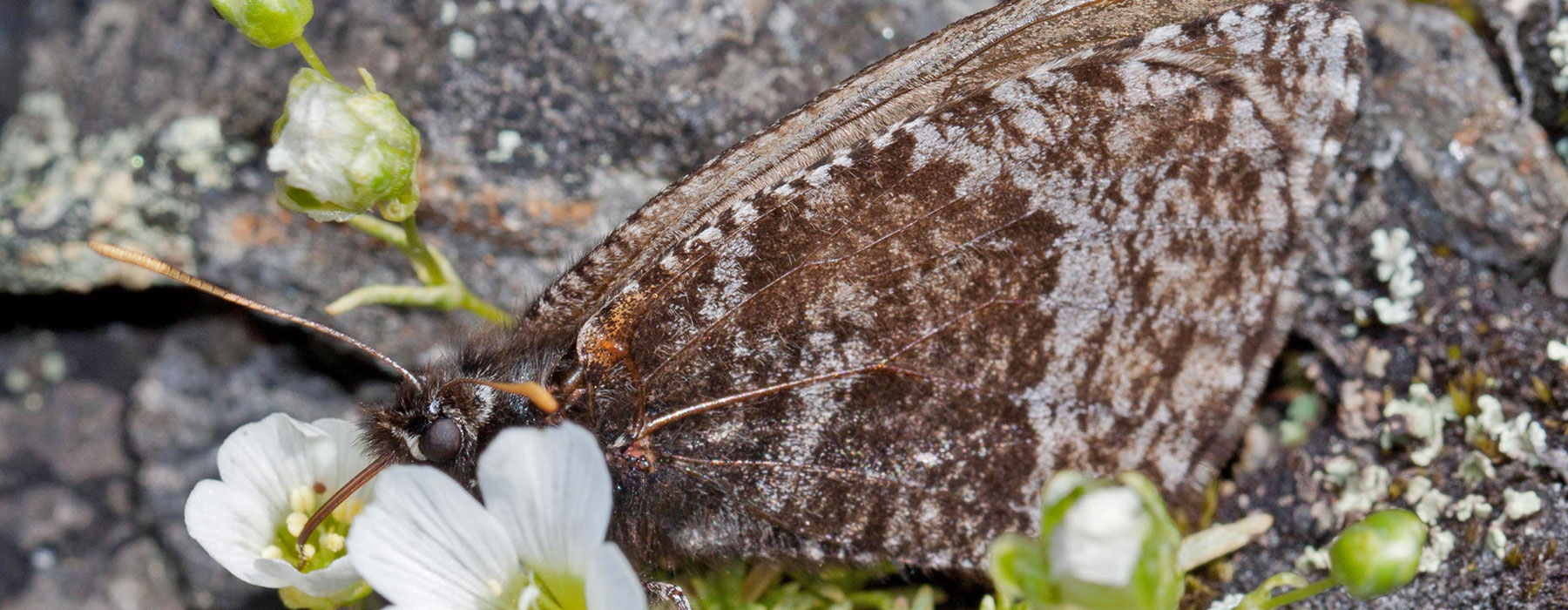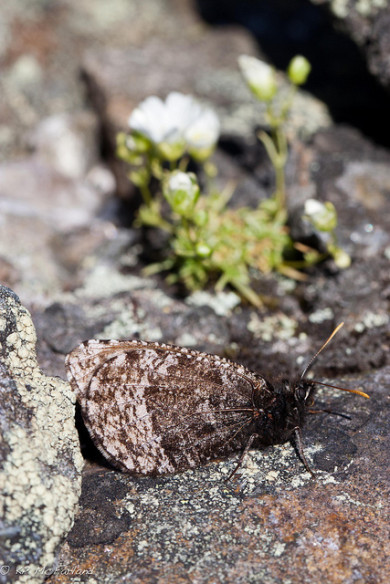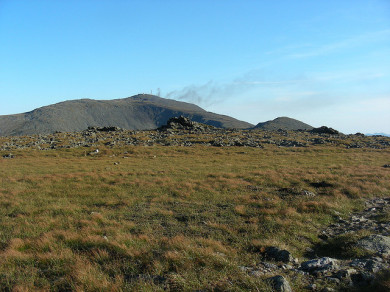The White Mountain Arctic is found only in the highest alpine zone in the Presidential Range in the White Mountains of New Hampshire around Bigelow's Sedge meadows. It is hard to imagine butterflies with wing spans of less than one-and-a-half inches surviving the fierce weather of Mount Washington, but these are especially adapted.
Most butterflies complete their life cycle in less than one year. Because alpine summers are short, it takes two years of nocturnal dining Bigelow’s Sedge for White Mountain Arctic caterpillars to mature. It isn't until the third summer that they finally pupate under a rock, emerge from their chrysalis, mate, and lay eggs in late-June to mid-July. Because of their prolonged life cycle, these have some of the longest life spans known for butterflies. VCE's work with alpine butterflies have been instrumental in creating conservation awareness for this species. These unique butterflies are now formally recognized as “sensitive species” by the White Mountain National Forest. And, the New Hampshire Fish and Game Department listed them as threatened in 2008.
White Mountain Arctic News
 July 17, 2012
July 17, 2012
Field Trip to See White Mountain Arctic
Read a first hand account from the blog, A Naturalist's Table, on joining VCE biologists on a field trip to see the White Mountain Arctic. more » June 01, 2010
June 01, 2010
AMC Outdoors: Butterflies on High
As you pause near Cragway Spring along the Mount Washington Auto Road on a sunny day, your gaze might land on a small moth-like insect drawing nectar from a goldenrod bloom. Higher up, you might spy a dull-colored butterfly nearly invisible against a rock in the sparse meadows of Bigelow's sedge. And you might keep walking, thinking both are inconsequential. But these tiny mountain butterflies are all about adaptation and sheer grit. more »Natural History
Adults fly from late June to late July. They are only active on bright sunny days with wind below about 40 mph and temperature above 45° F. They rarely fly more than a few feet above ground, but if disturbed they may be carried by the wind for several hundred yards, often downslope. Males tend to fly farther than females, probably actively searching for females. Females remain in areas where sedges are dominant. Males perch and patrol hill tops and ridgelines during most of the day. They often nectar Moss Campion (Silene acaulis) and Mountain Sandwort (Arenaria groenlandica) as well as Vaccinium species.
Eggs are laid near base of sedges or in the litter around them. Most eggs apparently laid by last week of July. They hatch in 9-14 days, usually during the first week of August. The only known host plant in the White Mountains is Bigelow’s Sedge (Carex bigelowii). Larvae feed at night on sedge leaves and rest under stones during the day. Full grown larvae have been found from 20 July to 2 August.
Pupation occurs under moss, rocks or soil. Scudder (1889) reports that one person searched for 10-12 hours raising movable surface stones along the edges of fellfield areas and found two live pupae and nine others either infected with parasites or empty shells from the previous year. All of them were found imbedded between 0.5 – 1.5 inches below the surface. They were not attached to anything, but lay in horizontal oval cells. Areas chosen by larvae for diurnal concealment are probably the same places chosen for pupation; a level, damp and cool protected spot.
Two years are required for growth and development. The first winter is passed in second or third instar and the second winter as mature larvae (fifth instar). Scudder (1889) found a larva on 31 May. It changed to chrysalis on 2 June in captivity and emerged on 19 June, but development was probably faster due to warm conditions in captivity. He reported live chrysalis being found between 10 June and early July. Despite this biennial development, adults are found flying every year.
Habitat and Distribution
Its entire range is limited to the alpine zone of the Presidential Range in the White Mountains, New Hampshire, generally above 1,500 m elevation. Its presence is dependent upon quantity of its host plant, Bigelow’s Sedge. Populations tend to be locally abundant around sedge meadows, with few individuals found between them. Alpine sedge meadows cover approximately 80 hectares or 7% of the alpine zone. Among alpine plant communities, sedge meadows are found on moderate slopes in the highest elevations (range = 1,345 – 1,901 m) with an aspect tending to be oriented to the northwest. These meadows are largely dominated by Bigelow’s Sedge and Highland Rush (Juncus trifidus), with other potentially common species being Mountain Sandwort (Arenaria groelandica), Mountain Cranberry, Alpine Bilberry and Three-toothed Cinquefoil (Potentilla tridentata). Adults are most often reported from the following sedge meadows listed north to south: Monticello Lawn on Mt. Jefferson, area surrounding Gulf Tanks along the Mt. Washington Cog Railway between the summits of Mt. Washington and Mt. Clay, the Cow Pasture (relatively flat area at mile 7 on the auto road), and Bigelow Lawn (directly south of Mt. Washington summit). The most northern record was from Mt. Adams and the most southern was from Bigelow Lawn.
Population Status and Viability
The New Hampshire Natural Heritage global ranking is G5T2 – species is globally secure, but subspecies population imperiled because of rarity (generally 6 to 20 occurrences) or other factors demonstrably make it very vulnerable to extinction. Statewide ranking is S2 – state population imperiled because of rarity (generally 6 to 20 occurrences) or other factors demonstrably make it very vulnerable to extinction.
Scudder (1889) gives some historic perspective on the population,“…in its season this butterfly is exceedingly abundant.” He also reports that Oakes (a botanist at that time) found them “abundant” in June 1826 and Morrison (unknown observer) called them “very abundant” in first week of July 1874.
A student conducted mark-recapture sampling in the Cow Pasture from 27 June – 7 July 1969, marking 51 individuals, but never recapturing any. From 8 July – 15 July he collected 5 males and 14 females at Monticello Lawn, 31 males and 11 females around Gulf Tanks, 58 males and 23 females in the Cow pasture, and 17 males and 10 females at Bigelow Lawn. There appears to be similar numbers today.
Reports and Publications
- McFarland, K.P. 2003. Conservation Assessment of Two Endemic Butterflies (White Mountain Butterfly, Oeneis melissa semidea and White Mountain Fritillary, Boloria chariclea montinus) in the Presidential Range Alpine Zone, White Mountains, New Hampshire. (PDF)
- Anthony, S. G. 1970. Field work on the population structure of Oeneis melissa semidea (Satyridae) from the Presidential Range, New Hampshire. Journal of Research on the Lepidoptera 7(3):133‐148.
- Gradish, A.E. 2014. Population Structure, Phylogeography, and Conservation of Two North American Artic (Oeneis spp.) Butterflies. PhD thesis presented to The University of Guelph. 183pp.
- Gradish, A.E., Keyghobadi, N. and G.W. Otis. 2015. Population genetic structure and genetic diversity of the threatened White Mountain arctic butterfly (Oeneis melissa semidea). Conservation Genetics 16 (5): 1253‐1264



